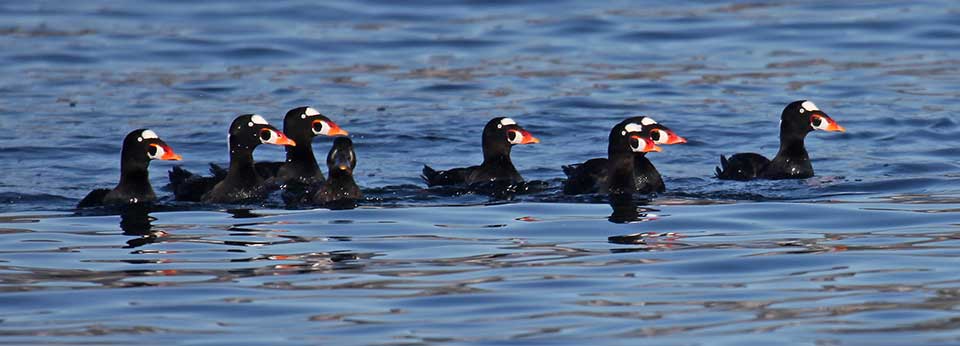Lead Institution(s): Simon Fraser University
Collaborator(s): Erika Lok (SFU), John Takekawa (USGS), Sean Boyd (CWS), Susan Wainwright-De La Cruz (USGS), Matthew Wilson (USGS), Dave Nysewander (WDFW), Joe Evenson (WDFW), David Ward (USGS), Eric Anderson (UW), Jim Lovvorn (UW)
Focal Species: Surf Scoter (Melanitta perspicillata)
Project Description: As part of a collaborative study of Surf Scoter spring migration ecology, this project combined satellite telemetry, radio telemetry, and surveys to document spring distributions of Pacific Surf Scoters throughout Southeast Alaska, with a focus on identifying important stopover areas and associated habitat attributes. We also collected birds to obtain information on spring energetics. This project had several objectives: (1) to identify important Surf Scoter late spring migration stop areas, (2) to identify habitat attributes that correspond to identified important areas (e.g. herring spawn events, bathymetry, substrate type), and (3) to relate the spatial and temporal use of these sites to their habitat attributes. This work contributed to studies of body mass variation in relation to areas (e.g., San Francisco Bay and Strait of Georgia), seasons (late winter, pre-migration, migration), and spawn occurrence, as well as to studies of the cross-seasonal persistence of contaminants in Surf Scoters, and provided an important link for understanding nutritional status and relationships among wintering, migrating, and breeding areas.
SDJV65 Interim Report FY05
SDJV65 Interim Report FY06
SDJV65 Final Report FY07
Related Publications
Lok, E., D. Esler, J. Takekawa, S. De La Cruz, W. Boyd, D. Nysewander, J. Evenson, and D. Ward. 2012. Spatiotemporal associations between Pacific herring spawn and surf scoter spring migration: evaluating a “silver wave” hypothesis. MARINE ECOLOGY PROGRESS SERIES 457:139–150. https://doi.org/10.3354/meps09692
Lok, E., D. Esler, J. Takekawa, S. De La Cruz, W. Boyd, D. Nysewander, J. Evenson, and D. Ward. 2011. Stopover Habitats of Spring Migrating Surf Scoters in Southeast Alaska. JOURNAL OF WILDLIFE MANAGEMENT 75:92–100. https://doi.org/10.1002/jwmg.5
De La Cruz, S. E. W., J. Y. Takekawa, M. T. Wilson, D. R. Nysewander, J. R. Evenson, D. Esler, W. S. Boyd, and D. H. Ward. 2009. Spring migration routes and chronology of surf scoters ( Melanitta perspicillata ): a synthesis of Pacific coast studies. Canadian Journal of Zoology 1086:1069–1086. https://doi.org/10.1139/Z09-099
Lok, E.K., 2008. Site use and migration of scoters (Melanitta spp.) in relation to the spawning of Pacific herring (Clupea pallasi) (Doctoral dissertation, Simon Fraser University). https://www.collectionscanada.gc.ca/obj/thesescanada/vol2/002/MR46889.PDF?is_thesis=1&oclc_number=701242540
Lok, E.K., M. Kirk, D. Esler, and W.S. Boyd. 2008. Movements of pre-migratory surf and white-winged scoters in response to Pacific herring spawn. Waterbirds 31:385-393. https://doi.org/10.1675/1524-4695-31.3.385
